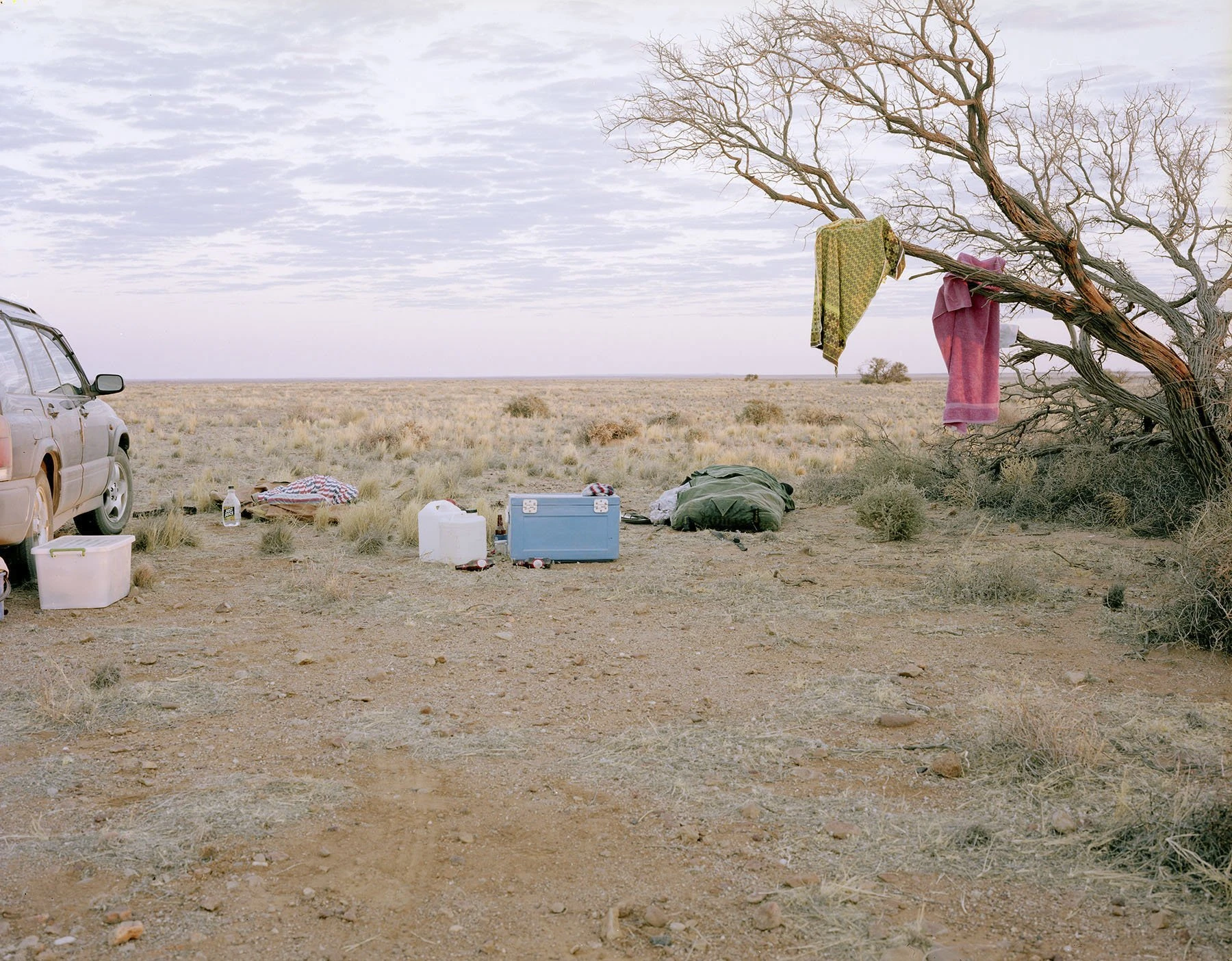27th July, 2024

“Camp, near William Creek, South Australia” by Jessie Boylan, a digital photograph taken in 2012, is a compelling example of landscape photography that challenges the traditional absence of humanity with the photographed natural world. This image is part of Boylan’s project “This is not nowhere”. It showcases a campsite in a vast, remote South Australian landscape, where anti-nuclear communities lead rich lives within the landscape they call home. This photograph lends itself to analysis through its rich composition, emotional and narrative qualities, and its exploration of environmental advocacy through landscape photography.
About Jessie Boylan
Jessie Boylan, an artist, documentary photographer, and journalist living in Djaara country, Victoria, Australia, is renowned for their journalistic, artistic, and documentarian work. Boylan’s landscape photography consistently intertwines environmental and social justice issues through a focus on human disruption and reliance on land. Their focus on climate activism, indigenous land rights, and LGBTQ+ communities has made Boylan’s work a significant contribution to the discourse on social and environmental issues for over a decade.
Boylan grew up in the activism community – with her father involved in anti-nuclear work in Sydney. Growing up in Canberra, they had access to bushland and reserves in the area. This meant that Boylan “grew very attached to the natural world as a young person, finding solace in the spaces between the suburbs, as well as the freedom and physical and mental space that those places provide.” (Sydney Morning Herald, 2015)
In the words of Boylan, their camera was “an extension of freedom and exploration to look closer at people and places” (SMH, 2015). Boylan’s work has been showcased worldwide, as they have considered, created, and exhibited it in various locations – from their base in Victoria to China, Italy, New York, France, Canada, and Berlin. (Jessie) Along with this, Boylan has written prolifically about the subjects surrounding her artistic works.
What’s in a title?
The title of the image, “Camp, near William Creek, South Australia” not only discloses the location but also suggests the presence of the people who live there, and their non-invasive lifestyle. For example, it does not have the title “home”. It is careful not to impart specified context around the image. To a viewer who is unaware of the broader project it belongs to – it is simply a pleasing photo. “Camp” suggests a narrative quality – which is supported by the similarly simplistic but intriguing scene at hand.
Typically, photographers title works of landscape photography according to the place they are depicting. In part, this is a method of categorising images such as this as a landscape photo. Art scholars such as Franklin, Becklen and Doyle (1993) agree that the titling of artistic works have the ability to significantly influence the viewer’s understanding of an image, while formalists argue that “titles should function simply as identification tags, not as sources of meaning for the viewer” (Fry, 1920).
The advent of photography marked an ongoing debate about the validity of art photography, which extends to photographs taken for documentary purposes, such as Bolan’s work. As such, the name of this image speaks to how the viewer may interpret it. A simple location tag invites no wonder where the inclusion of the title ‘camp’ marks the image as one to be more contemplated.
Handling the Subject, Composition & Light
The subject of the photograph lives in the gentle disruption offered by the campsite’s objects, which are scattered naturally across the frame. Compositionally, the colourful towels and the tree that they hang from naturally draw the viewer’s eye. Boylan’s use of composition and light contributes to creating a sense of comfort and familiarity. “It is a direct reference to my relationship with the landscape. It shows my love for travelling in the ‘outback’ as a way of locating my place within the Australian physical/social/political/cultural landscape. To me, it suggests a journey and sense of familiarity and comfort within the landscape,” said Jessie to The Sydney Morning Herald, 2015.
With the bright and gentle colour palette enhanced by the golden hour light, the remnants of humanity do not appear disruptive or sinister. The objects stand out in the vast, dry landscape, exemplified by the lengthy foreground and far-off horizon, because of their vibrant colours. The frame cuts off the car on the left-hand side, rather than fully including it. This delivers a sense of awareness that there is more to the scene than the picture includes. All of its compositional qualities enhance the storytelling appeal of the photograph.
Documentary Photography & The Anti-Nuclear Movement
This photograph fits the genre of documentary landscape, specifically addressing the anti-nuclear community movement in South Australia. Since the 1980s, this area has been home to ongoing protest and resistance to uranium mining developments. “The very idea of “the middle of nowhere”; a term that government representatives and mining companies use when they are talking about Aboriginal communities or planning the next mining venture, or choosing a site for a national radioactive waste dump.” said Boylan (SMH, 2015)
Documentary Photography is in important medium, especially within stories of activism. Ina 2015 essay, Bolan explains that “chronicling the nuclear era through art can allow us to break free of our atomic amnesia and urge us to imagine possible alternative futures free of nuclear disaster.” (Boylan, 2015)
The Camera & Output Details
Digital cameras are a popular medium for documentary photography, as they capture an incredible amount of detail and are able to adapt to a range of shooting conditions. This photograph, assumedly taken on a current DSLR camera at the time, was captured between 2012 and 2015. Digital photography has revolutionised the way we document and share images, making it easier for photographers like Boylan to reach a global audience with her work in social activism.
Reflection: What can be learned?
From an interrogation of Camp, near William Creek, South Australia, I’ve become fascinated with landscape photography as a medium to explore humanity’s interwoven dependance on the natural world. Through a genre of photography that suggests the absence of people, we are able to explore how humanity might influence or disrupt landscapes. It would be interesting to explore this through compositional considerations that emphasise the character of the landscape and the reality of human existence within it.
References
- Boylan, J. (2012). Camp, near William Creek, South Australia [Digital photograph]. Retrieved from https://www.jessieboylan.com/work/this-is-not-nowhere
- Boylan, J. (2012). This is not nowhere. Digital. [Online] Available at: https://www.jessieboylan.com/work/this-is-not-nowhere
- The New Storytellers: Jessie Boylan. (2015). The Sydney Morning Herald. [Online] Available at: https://www.smh.com.au/national/the-new-storytellers-jessie-boylan-20150910-gjjkzq.html
- Boylan, J. Info. [Online] Available at: https://www.jessieboylan.com/info
- Franklin, M. B., Becklen, R. C., & Doyle, C. L. (1993). The Influence of Titles on How Paintings Are Seen. Leonardo, 26(2), 103-108. [Online] Available at: https://www.jstor.org/stable/1575894
- Fry, R. (2017). Vision and Design. [Online] Available at: https://www.gutenberg.org/files/54154/54154-h/54154-h.htm
- Jessie Boylan (2016) Atomic amnesia: photographs and nuclear memory, Global Change, Peace & Security, 28:1, 55-73, DOI: 10.1080/14781158.2015.1050367





